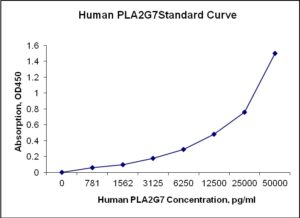Nori Human Lp-PLA2 ELISA Kit
$461.00 – $832.00
This ELISA kit is for quantification of Lp-PLA2 in human. This is a quick ELISA assay that reduces time to 50% compared to the conventional method, and the entire assay only takes 3 hours. This assay employs the quantitative sandwich enzyme immunoassay technique and uses biotin-streptavidin chemistry to improve the performance of the assays. An antibody specific for Lp-PLA2 has been pre-coated onto a microplate. Standards and samples are pipetted into the wells and any Lp-PLA2 present is bound by the immobilized antibody. After washing away any unbound substances, a detection antibody specific for Lp-PLA2 is added to the wells. Following wash to remove any unbound antibody reagent, a detection reagent is added. After intensive wash a substrate solution is added to the wells and color develops in proportion to the amount of Lp-PLA2 bound in the initial step. The color development is stopped, and the intensity of the color is measured.
Alternative names for Lp-PLA2: Lipoprotein-associated phospholipase A2 (Lp-PLA2), platelet-activating factor acetylhydrolase (PAF-AH), PLA2G7
This product is for Laboratory Research Use Only not for diagnostic and therapeutic purposes or any other purposes.
- Description
- How Elisa Works
- Product Citation (0)
- Reviews (0)
Description
Nori Human Lp-PLA2 ELISA Kit Summary
Alternative names for Lp-PLA2: Lipoprotein-associated phospholipase A2 (Lp-PLA2), platelet-activating factor acetylhydrolase (PAF-AH), PLA2G7
| Assay Type | Solid Phase Sandwich ELISA |
| Format | 96-well Microplate or 96-Well Strip Microplate |
| Method of Detection | Colorimetric |
| Number of Targets Detected | 1 |
| Target Antigen Accession Number | Q13093 |
| Assay Length | 3 hours |
| Quantitative/Semiquantitative | Quantitative |
| Sample Type | Plasma, Serum, Cell Culture, Urine, Cell/Tissue Lysates, Synovial Fluid, BAL, |
| Recommended Sample Dilution (Plasma/Serum) | No dilution for sample <ULOQ; sufficient dilution for samples >ULOQ |
| Sensitivity | 150 pg/mL |
| Detection Range | 0.781-50 ng/mL |
| Specificity | Natural and recombinant human Lp-PLA2 |
| Cross-Reactivity | < 0.5% cross-reactivity observed with available related molecules, < 50% cross-species reactivity observed with species tested. |
| Interference | No significant interference observed with available related molecules |
| Storage/Stability | 4 ºC for up to 6 months |
| Usage | For Laboratory Research Use Only. Not for diagnostic or therapeutic use. |
| Additional Notes | The kit allows for use in multiple experiments. |
Standard Curve
Kit Components
1. Pre-coated 96-well Microplate
2. Biotinylated Detection Antibody
3. Streptavidin-HRP Conjugate
4. Lyophilized Standards
5. TMB One-Step Substrate
6. Stop Solution
7. 20 x PBS
8. Assay Buffer
Other Materials Required but not Provided:
1. Microplate Reader capable of measuring absorption at 450 nm
2. Log-log graph paper or computer and software for ELISA data analysis
3. Precision pipettes (1-1000 µl)
4. Multi-channel pipettes (300 µl)
5. Distilled or deionized water
Protocol Outline
1. Prepare all reagents, samples and standards as instructed in the datasheet.
2. Add 100 µl of Standard or samples to each well and incubate 1 h at RT.
3. Add 100 µl of Working Detection Antibody to each well and incubate 1 h at RT.
4. Add 100 µl of Working Streptavidin-HRP to each well and incubate 20 min at RT.
5. Add 100 µl of Substrate to each well and incubate 5-30 min at RT.
6. Add 50 µl of Stop Solution to each well and read at 450 nm immediately.
Background:
Lipoprotein-associated phospholipase A2 (Lp-PLA2) also known as platelet-activating factor acetylhydrolase (PAF-AH) is a phospholipase A2 enzyme that in humans is encoded by the PLA2G7 gene.[1][2] Lp-PLA2 is a 45-kDa protein of 441 amino acids.[3] It is one of several PAF acetylhydrolases. In the blood it travels mainly with low-density lipoprotein (LDL). Less than 20% is associated with high-density lipoprotein HDL. It is an enzyme produced by inflammatory cells and hydrolyzes oxidized phospholipids in LDL. Lp-PLA2 is platelet-activating factor (PAF) acetylhydrolase (EC 3.1.1.47), a secreted enzyme that catalyzes the degradation of PAF to inactive products by hydrolysis of the acetyl group at the sn-2 position, producing the biologically inactive products LYSO-PAF and acetate.
Lp-PLA2 is involved in the development of atherosclerosis[3], an observation that has prompted interest as a possible therapeutic target (see, e.g. the investigational drug Darapladib). In human atherosclerotic lesions, 2 main sources of Lp-PLA2 can be identified, including that which is brought into the intima bound to LDL (from the circulation), and that which is synthesized de novo by plaque inflammatory cells (macrophages, T cells, mast cells).” It is used as a marker for cardiac disease.[4] A meta-analysis involving a total of 79,036 participants in 32 prospective studies found that Lp-PLA2 levels are positively correlated with increased risk of developing coronary heart disease and stroke.[5]
References
- Tjoelker LW et al. (1995). Nature 374 (6522): 549–53.
- Tew DG et al. (1996). Arterioscler. Thromb. Vasc. Biol. 16 (4): 591–9.
- Zalewski A, Macphee C (2005). Arterioscler. Thromb. Vasc. Biol. 25 (5): 923–31.
- Mohler ER et al. (2008). J. Am. Coll. Cardiol. 51 (17): 1632–41.
- The Lp-PLA2 Studies Collaboration (2010). The Lancet 375 (9725): 1536–1544.
Be the first to review “Nori Human Lp-PLA2 ELISA Kit”
You must be logged in to post a review.




























Reviews
There are no reviews yet.